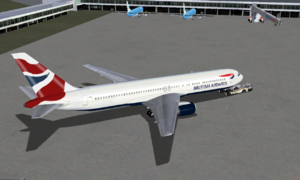Boeing 767-300
 | |
| Type | Long-Range Civil Airliner |
|---|---|
| Author(s) | Liam, Isaias V. Prestes |
| FDM | YASim |
| Status | Development |
The Boeing 767-300 is a long-range civil aircraft, built by Boeing. It was first flown in 1986, and is still operated by many major airlines. The 767-300 is expected to be replaced gradually by the new Boeing 787, in the future. It has a Freight version (767-300F), aswell as an Extended Range (Boeing 767-300ER) version, which has a longer service range and fuel capacity.
The 767-300's direct competitor from Airbus is the A330-200. The 767-300 is expected to be replaced by the 787-8 in Boeing's lineup. As of August 2009, total orders for the 767-300/300ER/300F stand at 749 with 690 delivered. This includes 104 orders (all delivered) for the -300, 563 orders for the -300ER (535 delivered), and 82 orders for the -300F (51 delivered). A total of 661 Boeing 767-300/-300ER/-300F aircraft were in airline service as of July 2009.
Stretched 269-passenger version, with 3.07 m (10 ft 1 in) plug forward of wing and 3.35 m (11 ft) plug aft, and same gross weight as 767-200; strengthened landing gear and thicker metal in parts of fuselage and underwing skin; same flight deck and systems as other 767s; same engine options as 767-200ER; first ordered (by Japan Airlines) 29 September 1983. First flight with JT9D-7R4D engines 30 January 1986; certified with JT9D-7R4D and CF6-80A2 22 September 1986. First delivery (Japan Airlines) 25 September 1986. British Airways ordered 11 in August 1987, later increased to total 25, with Rolls-Royce RB211-524H engines; delivered from 8 February 1990. No longer available; weight and performance data in 2000-01 and previous Jane's.
Key features
- The 767-300 typically cruises at 530mph, at a ceiling of 35,000ft. - The 767-300 variant has 230 seats in standard 3 class configuration.
- YASim FDM.
- Autostart control.
- Followme vehicle and other airport operations. Follow-me vehicle turns with aircraft and rotates on an axis when aircraft rudder is turned.
- Lights on automatically on autostart. to be switchable in future.
- Wing view/Tail view/Gear view.
- Livery Selection Dialog.
- Tyre smoke on landing.
- 3D cockpit with some panels and instruments modelled (PFD, SFD, Yoke, Pedals etc). (subject to future enhancements).
- Autopilot does work using autopilot menu's, not cockpit buttons as of yet.
- 2 General Electric CF6-80C2B6 engines.
- Vapour trails/Contrails and take-off engine moisture.
- Cabin SFX (Seatbelt alarm, various atmospheric cabin announcements).
- Pushback (Goldhofer).
- Many animations complete, including flaps, ailerons, both v/h stabilizers, landing gear and speed-brakes. Gear doors to be animated.
References
| |||||||||||